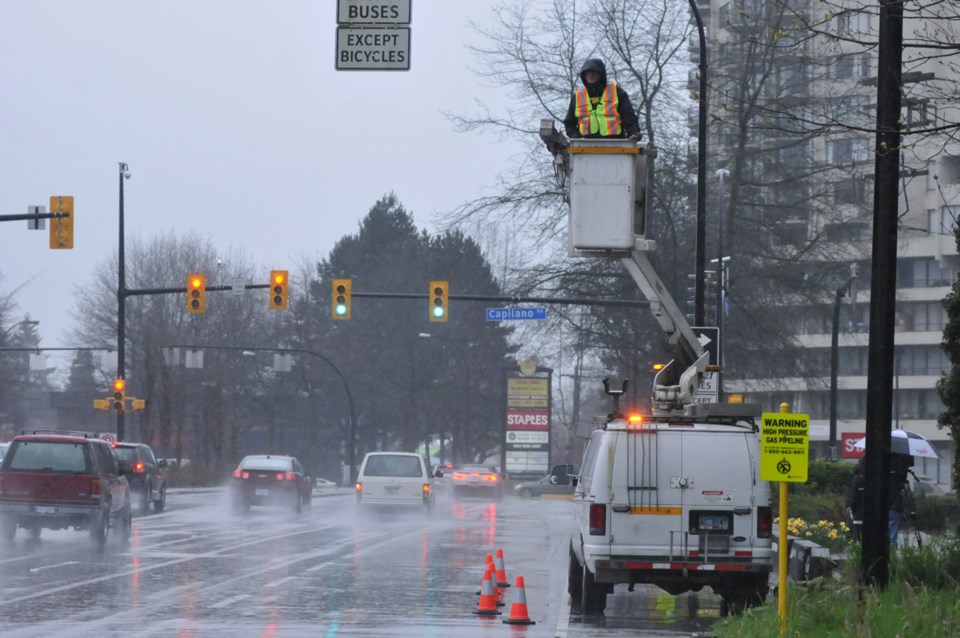Last week, North Shore drivers succumbing to the temptation to reach for their cellphones got an unpleasant surprise.
North Vancouver RCMP set up on Marine Drive in a utility truck, with an officer dressed as a worker perched high overhead. Quite literally, the police cherry picked distracted drivers out of the crowd, handing out fines for texting or using a hand-held device while driving.
Distracted driving is quoted as being a factor in one quarter of traffic fatalities in our province, and who knows how many less-severe collisions. We know it's wrong, it drives us nuts when we see others do it - and yet we do it anyway. Thus, the enforcement drive from police, intended to curb our use and maybe have the threat of a fine keep your phone in your pocket.
You'd think that the reaction from the public would be to laud the officers for their clever plan, and join police and public officials in condemning the use of phones while driving. However, that hasn't really been the case. In comments on public forums and via Twitter, responses seem split between those who agree with the crackdown and those who see it as unfair. The words "tax grab" get thrown around a lot. There are frequent calls to "get out there and catch the real criminals."
The problem doesn't seem to be so much the issue of phone use in cars. The public seems to accept that there's a danger associated with using a phone while driving, and while it's a commonly observed driving sin, people still think it's wrong. The difficulty seems to be the tactics used in enforcing the law, the idea of the trap.
This isn't the first time police have used some form of mild subterfuge to surveil traffic. Officers in Toronto posed as panhandlers, even going so far as to carry cardboard signs, the flip-side of which read, Hello I'm A Police Officer, If You Are Reading This You Are About To Get A Cellphone Ticket. Some wag came up with the headline: Hobocops.
Unmarked police cars are also a common sight on our roads. You can usually spot them by their low-spec steel wheels, extra aerials, and emergency lights peeking through the grille. However, approach one from behind and you might find a couple of bumper stickers, or perhaps even one of those stick-figure families that are so popular on civilian cars. That's not just leaving the badge in your pocket, that's camouflage.
Actual police undercover operations don't ordinarily use unmarked cars. Government-issued Chevy Tahoes and the like are pretty easy for the criminal element to spot, so an operation might use a civilian-spec rented hatchback or the like. The unmarked car is more to keep an eye on the public.
The public, understandably, does not enjoy being spied on.
For most people, the road is the most common place law breaking occurs. Few people would shoplift on the regular, but drifting over the speed limit by five or 10 kilometres per hour is very common; stand at the foot of the Lion's Gate Bridge on a weekday morning and only a very small percentage of traffic will be obeying the letter of the law. Stand there on a weekend, and you might be standing next to a traffic cop with a radar gun.
By using the cherry picker subterfuge to catch distracted drivers, police were sending the same message they do every time they set up a speed trap with an officer hidden from view. You won't see us until it's too late. We could be anywhere. Don't break the law, or we'll catch you.
You hear it in the radio ads that run periodically. "If you can't police yourself, we'll do it for you." That sort of thing. If you're a grown-up, tax-paying, law-abiding citizen, it's a bit annoying. Annoying becomes infuriating when the people we employ to enforce the law reveal themselves as fallible, as in the case of the North Vancouver RCMP officer who blew through a speed trap at excessive speed several years ago. The officer was later charged and fined heavily for what he claimed was a prank, but didn't receive the inconvenience of the roadside vehicle impounding that a member of the public would.
Whether high up in a cherry picker or hiding at the side of the road, too much police subterfuge makes the public grumble. It feels unfair somehow, underhanded, unsporting. It feels us-and-them. And there are arguments to be made both for and against the effectiveness of enforcement as a deterrent.
I'd like to make a radical suggestion: ditch the undercover stuff completely where traffic safety is concerned. For speed enforcement, most police departments are using lidar and radar systems that reach farther than unassisted eyes anyway. If you drive faster than the flow of traffic regularly, you'll get ticketed because you'll stand out even at a distance. Everybody else gets a chance to check their speed.
And instead of a cherry picker, the RCMP should bust out their best red serge dress uniforms and regularly stake out the busiest intersections in the city. Good drivers will be paying attention and won't reach for their phones. Distracted drivers? If you're too addicted to your phone to notice a Mountie in full gear, then take 'im away boys. Not just a fine either, maybe a confiscation of the phone entirely. Thus, the efforts of police won't just be another story about how many people got caught by mild sleight-of-hand, but of inattentive buffoons who had it coming. And, if you happen to screw up and check your texts when you should have both hands on the wheel, at least the person writing up your ticket will be a snappy dresser.
Brendan McAleer is a freelance writer and automotive enthusiast. Contact him at mcaleeronwheels@gmail. com. Follow Brendan on Twitter: @brendan_ mcaleer.
What are your thoughts? Send us a letter via email by clicking here or post a comment below.



